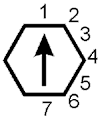
Facing Acc Decc
1 1 2 2 1 2 3 2 2 4 None None 5 2 2 6 2 1 7 2 1
| Variant Initiative Rules | BACK |
Roll 1d10 per unit (fighter, corvette, installation, etc) for initiative. Subtract one-half the unit's piloting familiarity bonus, the Pilot's Piloting Skill and add any Damage or Equipment modifiers.
1d10 + (Skill + Fam Bonus)/2 + Modifiers - Damage
Units move in sequence from highest initiative number to the lowest. Ties are re-rolled once; if the units tie once again (including all modifiers) then they move simultaneously. Each player secretly records where their units will end up, then each moves their fighter at the same time. At any time during movement, a unit of a lower initiative ranking (ie lower initiative number) may declare it wishes "seize the initiative." That unit then immediately moves, after which the regular sequence continues. Note that during a "seized" movement, the initiative can be seized again by another lower ranked unit. A unit can only move once per turn; ie, seizing the initiative does not grant the ability to move twice.
Ships may no longer fire at any point in the turn, they must fire during their movement. This is where 'seizing the initiative' comes into play most often. A ship can no longer automatically declare itself to go after another if persuing, see below.All other rules remain the same.
The net effect (or difference) is to make more skilled/experienced pilots (or those with better stats, if using the RPG) even more effective in combat in their ability to react quicker.
| Variant Pursuit Rule | BACK |
During a dogfight, pilots often get into the position of advantage of being in their target's cone of vulnerability, giving them the edge not only of greater damage possibilities, but also of the potential to "tail" them, reacting to their maneuvers and staying right on their six. In game terms, this means that under certain circumstances, a Pilot may attempt to pursue and move after a target with a lower Initiative Number.
In order to declare a pursual, the target fighter must be in the attacker's front deflection arc, while the attacking fighter must be in the defender's aft or line astern deflection arcs. (See below for deflection arcs)
The Pursuit roll is a piloting roll, modified by three things: the pilot qualities of both aviators, the difference between initiative ranks and any damage modifiers. The roll looks like this: (A = Attacker, T = Target)
1d10 vs A Pilot Skill - ( T Pilot Skill - A Pilot Skill) - ( A Init - T Init)
So, for example, if an init rank 8 Spiculum (Pilot 6) was attempting to trail
an init rank 5 Penetrator (Pilot 4), the roll would be:
1d10 vs (6 - (4-6) - (8-5) ) = (6 - -2 - 3) or 1d10 vs 5. Good luck!
| Variant Thrust Reversers and Accel/Decel | BACK |
All fighter craft are equipped with thrust reversers. These permit the fighter to decelerate without having to turn completely around. Thrust reversers are not as effective or as efficient a method for deceleration as using the main thrusters, but they are often far more convenient to use. (If turning around was the only way to decelerate, carrier landings would be near- well impossible!)
The amount of velocity gained or lost by a thrusting depends on the ships heading versus its facing, as determined on the table below.
 |
Facing Acc Decc |
1 1 2 2 1 2 3 2 2 4 None None 5 2 2 6 2 1 7 2 1 |
There are no other effects. (Adds cross-grain arcs to INT table)
| Variant Evasion | BACK |
There are times in combat when one would rather not take another hit. This is doubly true for units undergoing attack by a more powerful foe; often they are more interested in avoiding damage than they are in what little damage they could inflict. In such situations, a unit can use erratic maneuvering to reduce the chances of being struck. Also known as "jinking", a pilot who is using evasion is throwing her fighter around in minor but sharp and random changes in course around a base course. This gives enemy gunners the fits trying to figure out just exactly where to shoot. Of course, it gives the evading craft's gunner the fits as well.
To begin evasion, a pilot simply announces their intension to do so, immediately following the adjustment of their craft's velocity at the beginning of their movement phase. Erratic maneuvering costs one-half the unit's current velocity in thrust points. Units firing on the jinking craft suffer a -2 penalty to hit the fighter. Similarly, any fire from the craft also suffer a -2 penalty to hit. Running the ship around in random directions tends takes the pilot's mind off other things, reducing the amount of weaponry they may fire per turn to 3, a -3 (total) penalty to their gunnery, and giving them a -2 penalty to any other piloting rolls they may have to do during the turn. This makes jinking fun in asteroid fields...
| Variant Ground Row Movement | BACK |
According to the Interceptor rules, any craft ending its turn on a mapsheet with a ground row or atmosphere is moved one hex closer to the planet. Realistically, however, when a fighter gets within fifteen kilometres of the ground, it's planetary-handling capabilities are greatly improved, either through the higher-density atmosphere (for streamlined fighters) or a more intense gravity field (for ships using anti-grav). Therefore, craft should be permitted to fly along the atmosphere hex-row immediately above the ground hex-row without the gravity-pull penalty. (1st Edition Rule)
| Variant Self Destruct | BACK |
"Don't let that fighter fall into enemy hands!"
Pilots wishing to self-destruct their craft must only roll a Piloting Check, with appropriate damage modifiers added in. If failed, there is no effect. If successful, the craft will explode in 1-3 minutes, destroying it and killing any crew inside unless they eject, or have climbed out during the intervening time.
| Variant Firing Arcs | BACK |
This rule reverts a fighter's firing arcs to the 1st edition's, or something more akin to it. This gives fighters a more limited firing arc due to the fixed nature of their weapons when compared to larger ships which are capable of articluated mounts. Obviously, this drawback is negated partially by the fighter's greater maneuverability, but the new arc seems a bit broad (if though it makes more sense (the counter only represents a guestimate of the interceptor's true facing)
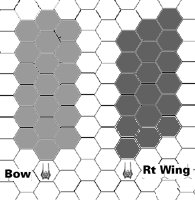 |
These are the old arcs for Interceptor-Mounted weapons when the craft is travelling via normal and cross-grain movement. | 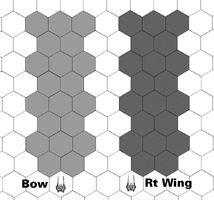 |
 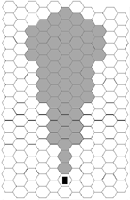 |
These are new arcs for Interceptor-Mounted weapons when the craft is
travelling via normal and cross-grain movement. (15~ arc approx) Below is the arcs
(Bow and Wing) combined.
|
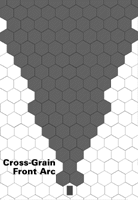 |
| Variant Salvo Fire | BACK |
(This is a 1st Edition Rule, but can be used in place or in addition to TOT in 2nd ed)
Often Interceptors have paired sets of weapons, that is, identical weapons in each wing and/or in the nose. Using Salvo Fire, pilots and gunners may fire these sets of ordinance simultaneously at a single target.
To declare Salvo Fire, the following requirements must be met: all the firing mounts must be of the same weapon type and damage capacity (ex 3 MDC10s), they must be direct-fire-weapons (no missiles) and all the weapon mounts to be discharged must be able to fire at the target, taking into consideration the relevant firing arcs and range.
Under Salvo Fire, one attack roll is made for all the weapons involved. (This works better under the optional Shield Rules, where a separate roll is made for hits and for shield penetration--all the weapons may strike the target, but the shield penetration rolls are done individually.) If it is successful, all the firing mounts strike the target (though each allocate and apply their damage separately); if the roll fails, all the weapons miss the target, period. In other words, it's an all-or-nothing shot!
For the purposes of allocating how many weapons a crewmember can fire in a turn, weapons fired in a Salvo count as follows: (2x#Weapons Discharged)/3, rounded off. Therefore, two weapons fired in Salvo would count as 1 weapon fired, while 4 so fired would count as 3.
| Variant Size Based To-Hit Modifier | BACK |
The following table shows the size of the target and the to-hit bonus for an opposing ship firing on them.
| Ship Class | Front | Side |
|---|---|---|
LF MF HF GB LC MC HC Es | +0 +0 +0 +0 +1 +2 +2 +3 | +0 +0 +0 +1 +2 +2 +3 +4 |
| Variant Angle of Attack Modifiers - Type A | BACK |
This is the simpler of the two new Angle of Attack Modifiers, and is simply an addition to the base rules in order to take into account the addition of cross grain movement. Starting with the Rear shot (as shown on P 21 of the Interceptor rulebook) and working one 30 degree turn at a time towards a front attack angle, the modifiers go: -0 | -1 | -2 | -3 | -4 | -2 | -1
As one can see, none of the original modifiers have been changed (ie, Left Frontside is still -4) and the new hex-point facings are simply the increment between the original hex-face modifiers.
| Variant Angle of Attack Modifiers - Type B | BACK |
While this method is far more complex, it also better represents AoA modifiers, particularly in the case of turreted attacks.
To determine the Angle of Attack Modifier, first determine in which deflection arc (see the accompanying diagrams for a craft's deflection arcs) the target occupies relative to the attacker, and vice versa. Then, looking on the chart below, cross reference the two results. If the chart indicates a +x or -x number, then that is the deflection modifier. If the chart indicates a x.x, then find the target's speed on the chart to the right, and multiply it by the x.x number. This then becomes the Angle of Attack modifier.
| Target is in this Deflection Arc of the Attacker |
Attacker is in this Deflection Arc of Target
Fwd FrQ RrQ Aft L A |
Target Speed Mod |
Forward Front Quarter Rear Quarter Aft Line Astern |
0.5 2.0 1.0 +0 +1
1.5 1.0 0.5 0.5 +0
1.0 0.5 1.0 1.0 0.5
-1 1.0 1.0 0.5 N/A
-1 1.0 1.5 0.5 +0 |
0 +1 1 +0 2-3 -1 4-6 -2 7-10 -3 11-15 -4 16-21 -5 22-29 -6 30+ -7 |
Deflection Arcs: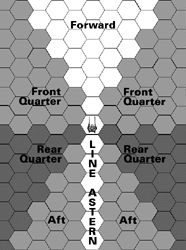
| Variant Missiles | BACK |
To begin: the weights of the missiles are changed, giving more variance. A hardpoint can mount as many missiles as it has weight, up to a maximum of 4 missiles per HP.
Further (optional): This reverts the missile mechanics back one notch to 1st edition, in that missiles no longer automatically move to their target and hit, instead, they must suffer travel time giving fighters a chance to outmaneuver or shoot down incoming missiles.
HELLs are no longer available as a dogfighting missile. Instead, the only HELLs available are torpedos, usable against larger ships and installations.Missiles: Initial velocity = firing craft vel +1 DAP 3t Thrust 18 DFM 1.5t Direct-Fire RIS 1.5t Thrust 14 SSS 2t Thrust 16 TGM 2t Thrust 16 Cost to turn 1 hexface = 0
| Variant Shield Rule | BACK |
The following rules split the to-hit sequence for direct-fire weapons into two autonomous phases: checking to see if the weapon strikes the target, and then a separate roll to see if the weapon actually penetrates the target's shield. Separating the two actions may be more accurate in representing the weapon's chances of getting through the flicker shield. (NOTE: this has already been done in the 2nd edition rules)
Using the statement in the Interceptor Technical Manual "Under combat conditions, a shield rated at 70 would intercept most incoming attacks 50 percent of the time", shield ratings and their associated percentages were extrapolated.
Under this rule, the to-hit sequence is slightly modified. First, the firer rolls to hit as normal, applying all relevant modifiers, EXCEPT for the shield factor. If this roll is successful, the weapon has connected, and must then check for shield penetration. Each shield rating has a percentage associated with it, listing the chance the shield will stop the round. Simply make a percentage roll against the listed value--if it succeeds, the shield stopped the impact; if it fails the weapons goes through the shield, and hits the hull beneath. Damage amount and allocation remains unchanged. This system is used for direct fire weapons (MDCs, EPCs, NPCs, Lasers, TPPs, etc) only. There are no changes to the base rules for missiles or any other weapon.
Shield % |
Shield % |
Shield % |
Shield % |
10 20 |
60 48 |
110 68 |
160 84 |
| Variant Danger Space | BACK |
This simply adds a modifier for other ships in the same hex. Since they weren't being aimed at, they are unlikely to be hit.
Target: Mod: |
|---|
2nd -3 3rd -5 4th -7 5th -8 6th -9 7+ -10 |
| Variant Damage Rules | BACK |
These rules affect the way damage is taken and recorded, replacing both editions. It is quite similar to the rules in Centurion, but takes the concept one step further, as well as integrating the two into a set that is consistant between them.
Affecting the way damage is recorded, and in some cases, the way internal components are damaged or destroyed, these alternate rules essentially follow the standard Centurion model of damage notation, save the "shape" of the tank and the "shape" of the internals. Furthermore, this system has been adapted to Interceptor as well, unifying the two systems in terms of damage demarkation. (The Interceptor rules are great as they stand, but this way is faster, can be a bit more interesting, and in times of the two games meeting, the unification helps make more sense)
The change in the vehicle's record now takes more into account the actual internal layout of a tank/interceptor. As well, more related information is now shown on each sheet. One sheet is now required per tank, however, rather than one per platoon, so this is a bit of a drawback. Nevertheless I think it's worth this extra photocopying expenditure...
Alternate Damage Allocation
Before play, fill out the appropriate record sheet, much as one did before:
Vehicle Name - The name of the tank. (ie, Screaming Betty) Class - The tank's class (ie, Liberator) Weapon Record - List the vehicle's weapon, it's location, maximum range, any to-hit modifiers it has, (ex: TES system, poor manufacture, etc) and the damage it does. Crew Record - Write in the crew's names and their relevant skill levels. Infantry - Note the infantry squad's name (The Happy Bouncers) and their type (Bounce, Foot, Mortar, etc). List their heavy weapon type (TVLG, Mortars, etc and fill in the appropriate boxes), their MPs and any notes. Armour Allocation - Remains unchanged. Shield Factors - A single diagram now shows all shield factors. Missile Records - Unchanged in Centurion, save new section for HMs Digging/Smoke - Same as before. ECM - Note if the fighter has an ECM pod and how many ECM missiles it carries. Maximum Thrust - Fill in the vehicles maximum, 3/4, 1/2 and 1/4 thrust values. Power Plant - Fill in the vehicles full, 3/4, 1/2 and 1/4 power plant values.
Recording Damage is done exactly as it is on the standard Centurion record sheet. Apply damage to the appropriate armour facings, using the templates, rolling for column, and so on. Armour is widowed, and damage continues internally just as under the Centurion rules, with no changes.
However, internal components are not destroyed in the same way. Instead of expiring on the first hit, a die is rolled versus a target number, based on the accumulated damage, to see if the component survives or is wasted. Destroyed pieces of equipment hamper the vehicle just as described in the Centurion or Interceptor rules; the only change is the method of determining if and when they are rendered out of commission. If a component has two locations, it is the total damage done on both locations that is used when referencing the item's Save Target Number. Note that both locations do not need to be hit for the item to be rendered inoperative, all that is required is a failed roll.
There are certain cases when a vehicle does not have a particular element, yet it is still listed on the record sheet. (The Infantry Bay is the most common occurrence, but it can also be one of the Weapon Locations. Laser Capacitors also count as ammo (they can explode) so not having any missiles, gauss or MDC weapons does not exclude one from having an ammo bay. Unless your vehicle isn't carrying _any_ weapons, you have an ammo bay. -grin-) When this situation arises, the following rule applies to damage incurred on the record sheet: The location absorbs damage and acts normally for the first hit it takes, but for the first hit _only_. Immediately following the first weapon strike, _all_ boxes for that component are marked off as destroyed. Essentially, the component no longer exists there.
For eample, a Trajan tank takes a hit on it's Stern facing from a Liberator. The 5/6 laser and the 150mm strike the tank. The 150 rolls the number 5 column, which already reaches 2 boxes into the tank, while the laser hits the number 6 column, which still has 4 points of armour on it. The laser, having been fired first, manages to bore a hole into the (truthfully non-existent) infantry compartment. The one point of damage is assessed, and then the _entire_ infantry compartment is scratched out. Next, the 150's hit is assessed. With the infantry compartment gone, the APDS shell sails into the Power Plant, crumpling it. HOWEVER, if the weapon hits had been reversed, the 150mm would have done but 3 points of damage to the engine (the infantry compartment working to its fullest extend during its first hit), and the 5/6 laser would have done nothing save taken off more armour and ballistic protection. (Unless the Alternate Laser Damage rules are being used from the Technical Update, in which case a whole point of damage would have been inflicted upon the Power Plant).
It may sound a bit complicated, but in practice, it isn't.
Damage Locations and Damage Assessment
The tables represent the target number required to be rolled to avoid a section being destroyed. The top row represents the amount of damage done to the component (in # of boxes done) while the second row is the target number itself. Many modules have a second save to prevent the item from shorting out for one turn. If this roll fails, the item is unusable the following turn, but is functional the turn after that (provided it isn't destroyed or shorted out again).
| Record Sheets: | 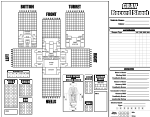 Centurion GIF Centurion TIF files (.zip) Centurion Damage Process |
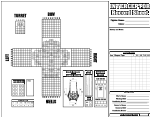 Interceptor GIF Interceptor TIF files (.zip) Interceptor Damage Process |
| Variant DFM and Laser Damage | BACK |
DFM damage should be handled the exact same way SMLM damage is handled in the Centurion Technical Update, for the same reasons. As well, handle laser damage as described in the Technical Update.
Alternate DFM Rule: DFMs are a cluster of rockets, gang-fired to saturate the target. As such, they do wildly varing damage depending on how many rockets make contact. To reflect this, use the following rules to determine damage inflicted:
Roll 2d10 +1/roll over what was needed to hit
-2/roll under what was needed (so if you roll well, hit w/ more)
-shield rating/10
Allocate Damage in 1 point hits
DFMs continue to recieve their to-hit bonus of +4
| Variant Construction Rules (for 2nd edition) | BACK |
This reverts some of the construction rules back to the original 1st edition. I prefer the smaller profile of fighters vs the larger ships.
Keep 4 shield facings for fighters, return shields to 2/generator (to regain some of the weight). Turrets have a smaller armour block of 5x5 boxes max, and are hit 10% of the time. To further regain weight, and to make for more variance at lower engine ratings, 50 rated engines weigh 1/2 a ton, add 1 ton to engines betwen 250-350, and two tons to all engines 400 and above. This nearly re-balances the tonnage.
| Variant Number of Weapons, Weapon Placement, Ship Class, etc | BACK |
A pilot flying an interceptor may elect to fire up to four single weapon systems in a turn. (Where weapon system counts as a single hardpoint, a single direct fire weapon, or several direct fire weapons discharged under Salvo Fire.)
As a gunner is not busy trying to fly the craft at the same time, they may fire up to six individual weapon systems in a turn. Direct-fire weapons, however, may only be fired from a turret, and from only one turret. (They cannot fire a ship-mounted weapon, as they have no control over where it is pointing) They may, however, fire any of the craft's missiles.
Ships may mount weapons as follows:
SHIP CLASS |
TONS |
BOW WINGS TURRET FACINGS ARMOUR/FACING |
Light Fighter |
< 100 < 225 < 350 < 500 < 1000 < 2500 < 5000 > 5000 |
2 2 3 4 100 3 4 4 4 100 4 4 5 4 100 5 5 6 4 150 No Limit + Sides 8 6 200 No Limit + Sides 8 6 230 No Limit + Sides 8 6 260 No Limit + Sides 8 6 300 |
|---|
(1st Edition Rules Follow)
There are no more x-hex class ships. All ships counters are now one hex.
(See Leviathan for further details) Maneuverability for a ship is determined
by its thrust and its class.
Interceptors may turn as many hexsides in a single hex as they desire.
Gunboats are essentially heavier Interceptors, and they may make one heading change per hex. Units firing at a Gunboat gain a +1 bonus to hit, due to their larger size and lower maneuverability.
Patrol Class ships and Corvettes are larger, more powerful affairs. (The original 2-hex ship) They must travel at least one hex straight before making a heading change. Units firing at a Patrol Class ship gain a +2 bonus to hit.
Escort vessels are the border between the big leviathans and the smaller fighter-class ships. Escort ships need to move two hexes in a straight line before they may change heading.
(On first glance, both the Gunboat and Patrol class ships seem limited in the same fashion--"one turn per hex" and "must travel one hex before turning" work out to the same thing. HOWEVER, the difference lies in the fact that the Gunboat need not declare its turns before executing them... so, for example, it could turn right at the start of its movement before moving forward any hexes (provided it hadn't already turned in that hex.) The Corvette, on the other hand, if it wished to execute a turn right at the start of its movement, would have to declare it's turn, and then proceed forward for one hex before it could actually change heading. It is a big difference, and turn declarations MUST be enforced in order to preserve this. See the Leviathan rules for more details.)
Page design/contents Kannik, 1997